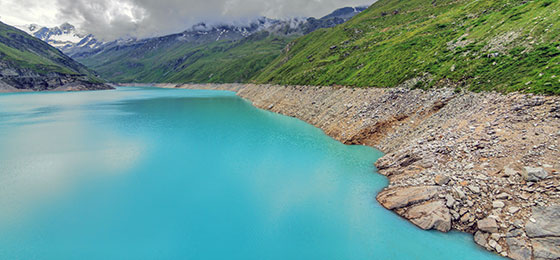Improving hydropower through long-range drought forecasts

Changing climatic conditions pose extra challenges for hydropower plant operators. As part of the National Research Programme “Energy Turnaround” (NRP 70), researchers at WSL, MeteoSwiss and ETH Zurich have now developed a complex hydrological model that enables spatially detailed forecasts of persistent dry spells using real-time data. This allows reliable predictions of water scarcity over a period of up to three weeks.
Massimiliano Zappa of WSL, who heads the project, explains the advantage of such forecasts: “With climate change, dry spells will become more frequent and intensive, and will last longer.”
Detecting these periods reliably is important for many reasons: long-range drought forecasts benefit agriculture and inland waterway transport; authorities could encourage people to conserve water at an early stage, or could save fish from rivers where water is low or too warm.
This information is particularly useful for operators of reservoir power stations. “But up to now, forecasts have generally not been made over such long periods because of the high complexity and enormous amounts of data”, says Zappa.
Drought is easier to predict than precipitation, which can only be reliably forecasted up to five days at most. But dry spells are complex phenomena that depend on numerous climatic processes and regional factors such as intensity of water use, soil storage properties, expected soil moisture, water runoff and underground water reservoirs. Previously, Switzerland had no system capable of monitoring these local variables efficiently.
Making optimal use of available water
Long-range forecasts of inflow and outflow in the catchment areas of hydropower stations can be combined with predictions of price developments on the energy market to optimise operation and profitability. Up to now, hydropower operators had to rely on simple statistics such as multi-year averages of precipitation and runoff. The new procedure, however, allows them to estimate the water availability of each day of the following month.
“Reservoir power stations can generate up to 4 per cent higher earnings by making optimal use of available water on the basis of long-range forecasts. This is very important for the hydropower industry, which has come under pressure”, says Frédéric Jordan, CEO of Hydrique Ingéniers, the industrial partner responsible for the economic calculations.
It is in society’s interest that hydropower plants be able to predict the availability of water and convert the stored water into electricity when market demand is high. Only when hydropower plants can operate profitably even under changing climatic conditions will it be possible to finance modernisation and expansion, as envisaged by the Energy Strategy 2050, from their own resources.
The National Research Programmes “Energy Turnaround” and “Managing Energy Consumption”
The Swiss National Science Foundation’s National Research Programmes “Energy Turnaround” (NRP 70) and “Managing Energy Consumption” (NRP 71) are investigating the scientific and technological as well as socioeconomic aspects of the successful implementation of the Energy Turnaround.
Until the end of 2018, more than 300 researchers in more than 100 research projects will be working on substantially reducing energy consumption, developing new technologies and evaluating social prerequisites for their implementation in the next 10 to 30 years.
NFP 70 and NFP 71 are running concurrently. Owing to their many overlapping areas of interest, the two programmes are closely coordinated.
Further information on the individual research projects and the organisation of the National Research Programmes is available at www.nrp70.ch and www.nrp71.ch
Dr Massimiliano Zappa, WSL
Zürcherstrasse 111
8903 Birmensdorf
Phone.: +41 44 739 24 33
E-mail: massimiliano.zappa@wsl.ch
http://p3.snf.ch/project-153929
http://www.trockenheit.ch
http://www.snf.ch/en/researchinFocus/newsroom/Pages/news_181206_press_release_lo…
Media Contact
All latest news from the category: Power and Electrical Engineering
This topic covers issues related to energy generation, conversion, transportation and consumption and how the industry is addressing the challenge of energy efficiency in general.
innovations-report provides in-depth and informative reports and articles on subjects ranging from wind energy, fuel cell technology, solar energy, geothermal energy, petroleum, gas, nuclear engineering, alternative energy and energy efficiency to fusion, hydrogen and superconductor technologies.
Newest articles

NASA: Mystery of life’s handedness deepens
The mystery of why life uses molecules with specific orientations has deepened with a NASA-funded discovery that RNA — a key molecule thought to have potentially held the instructions for…

What are the effects of historic lithium mining on water quality?
Study reveals low levels of common contaminants but high levels of other elements in waters associated with an abandoned lithium mine. Lithium ore and mining waste from a historic lithium…

Quantum-inspired design boosts efficiency of heat-to-electricity conversion
Rice engineers take unconventional route to improving thermophotovoltaic systems. Researchers at Rice University have found a new way to improve a key element of thermophotovoltaic (TPV) systems, which convert heat…



